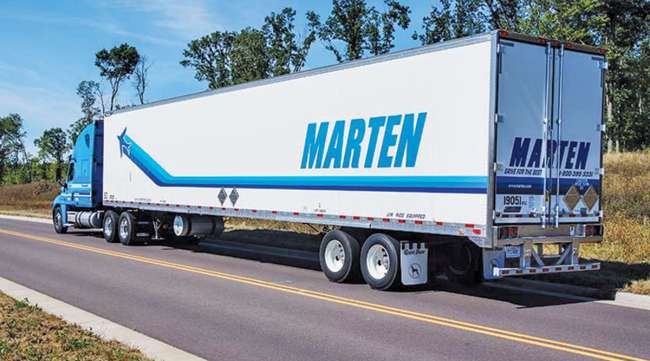Staff Reporter
Marten Transport Q4 Profit Halves on Freight Market Weakness

[Stay on top of transportation news: Get TTNews in your inbox.]
Profit at Marten Transport more than halved in the fourth quarter of 2024 as ongoing weakness in the freight environment hurt revenues and margins.
However, the Mondovi, Wis.-based carrier’s top executive, like many of his peers, sees some light at the end of the tunnel.
Marten reported net income of $5.6 million, or 7 cents per diluted share, in the three months that ended Dec. 31, compared with $12.4 million, 15 cents, a year earlier. The carrier’s revenue in Q4 totaled $230.4 million, down 14.1% compared with $268.2 million in Q4 2023.
Marten’s overall operating ratio came in at 97.1 in the most recent quarter, compared with 94.2 a year earlier. Operating ratio provides insight on how well a company is balancing its costs and revenue generation. The lower the ratio, the better a company’s performance.
Marten ranks No. 38 on the Transport Topics Top 100 list of the largest for-hire carriers in North America, No. 5 among refrigerated carriers, No. 23 on the list of the largest truckload carriers and No. 16 among intermodal/drayage haulers. It also ranks No. 87 on the TT Top 100 logistics companies list.
The company’s truckload unit posted an OR of 98.3 in the most recent quarter, compared with 97.8 in the same period 12 months earlier. Marten’s dedicated and intermodal operations reported ORs of 94.7 and 111.4 in Q4, respectively, compared with 90.3 and 98.4 in the year-ago period. But Executive Chairman Randolph Marten observed that the market is turning in favor of the company and its for-hire peers.
“We are encouraged by this quarter being the first quarter with sequential improvement in each of our net income, operating income and operating ratio, [and] net of fuel surcharges since the second quarter of 2022, a period that preceded the freight market recession’s severe inflationary operating costs, freight rate reductions and freight network disruptions,” the executive said.
“Our people also drove sequential increases this quarter in our revenue per tractor, rate per total mile and miles per tractor within each of our truckload and dedicated operations,” he added.
Marten’s truckload operations reported average revenue, net of fuel surcharges, per tractor per week of $4,227, compared with $4,183 in the year-ago period. The division’s average miles per trip inched higher to 535 from 533 a year earlier.
“We continue to focus on minimizing the freight market’s impact on our operations while investing in and positioning our operations to capitalize on profitable organic growth opportunities, with fair compensation for our premium services, across each of our business operations for what comes next in the freight cycle as the market moves toward equilibrium,” Randolph Marten said.
David Bell, CEO of CloneOps.ai, discusses the impact of AI on the trucking industry. Tune in above or by going to RoadSigns.ttnews.com.
The outlook for contract truckload rates in 2025 is positive, according to analysts.
Contract truckload rates have yet to bottom out, and negative year-over-year comparisons are expected for several months in 2025, according to FTR Transportation Intelligence Vice President of Trucking Avery Vise. Part of the reason is the absence of a rebound in carrier volume, particularly with industrial production remaining stagnant. However, FTR expects contract truckload rates to increase 2.2% on a full-year basis in 2025, Vise said during a Jan. 9 webinar, adding that by the end of 2025, contract rates will be rising 5% year on year.
And the Bloomberg/Truckstop semiannual freight broker survey shows brokers are optimistic about 2025, as demand and spot rates improved significantly in the second half of 2024.
Want more news? Listen to today's daily briefing above or go here for more info
“Most brokers believe demand, rates and margins are poised to keep getting better,” said Lee Klaskow, senior freight transportation and logistics analyst at Bloomberg Intelligence. “They also anticipate that the new administration could drive load growth, while higher rates and technological advancements may continue to support margin expansion.”
Some 77% of brokers expect load volumes to start increasing in the next three to six months, 28 percentage points more than in the first half of 2024, according to the survey.
The biggest wild card on when the improvement in demand and contract rates will begin is the threat of tariffs on the nation’s neighbors, Mexico and Canada. Trucks move 85% of goods that cross the United States’ southern border and 67% of goods that cross its northern border.





